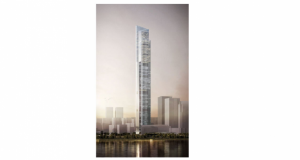Hitachi has announced that it’s installing the world’s fastest ultra-high-speed elevators in the Guangzhou CTF Finance Centre skyscraper in Guangzhou, China. Making up two out of a total of 95 elevators in the building, Hitachi says the new lifts use a range of technologies to produce  record-breaking speeds of 1,200 m/min while still meeting the necessary standards of safety and comfort.
record-breaking speeds of 1,200 m/min while still meeting the necessary standards of safety and comfort.
If you’ve ever had to walk up five flights of stairs, it’s easy to understand that it was the elevator that made the skyscraper possible. Without them, the prospect of going to the top of the Empire State Building would be as daunting as walking the length of Manhattan Island. Paradoxically, the elevator also limits the height of buildings. Among other limitations, they can only go so fast, so to prevent long delays waiting for the lift, skyscrapers are built with at most a couple of express elevators going from ground to top floor without any stops. The rest are a series of elevator shafts that require passengers to change cars at various floors – a bit like changing trains on a long journey.
This may be a bit tedious, but it gets the job done. The only problem is that taller the building, the more of the interior is taken up by elevators. And since extremely tall buildings tend to taper as they go up, a lot of valuable floor space is lost to moving people up and down.
When the CTF Finance Centre opens in 2016, it will be the tallest building in Guangzhou. The finished upmarket mixed-use skyscraper will be comprised of offices, hotel and residential space and will stretch to 530 m (1,738 ft) in height, with 111 floors above ground and five below ground. Hitachi is installing a total of 95 elevators in the skyscraper, including 28 double-decker cars, 13 high-speed elevators, and 52 low and medium-speed versions.
But the record setters are the two express elevators that travel from the ground to the 95th floor, a total of 440 m (1,443 ft), in about 43 seconds. That works out to 1,200 m/min (3,937 ft/min, or 44.7 mph/72 km/h), so there will probably be some stomach dropping on take off.
It achieves this speed by means of a thin-profile, permanent magnet synchronous motor and a compact traction machine that makes the lifting system lighter. This means the cable needed to lift the car is lighter and thinner, which reduces the size of the equipment to handle it, and thus the weight of the system is further lightened.
To regulate the speed of the elevator there’s a governor, and the braking system uses high-temperature resistant materials for emergency stops. In addition, there are guide rails designed to reduce vibration, and a pressure equalization system to avoid the annoyance of ear popping.
This is far from the company’s first foray into the high-speed the elevator market. In 1968, Hitachi installed Japan’s fastest elevator for the Kasumigaseki Building, Japan’s first skyscraper building. And since 2010 it’s been operating the world’s tallest elevator research tower, the 213 m (698 ft) G1TOWER, where the technology for the Guangzhou CTF Finance Centre was developed.






